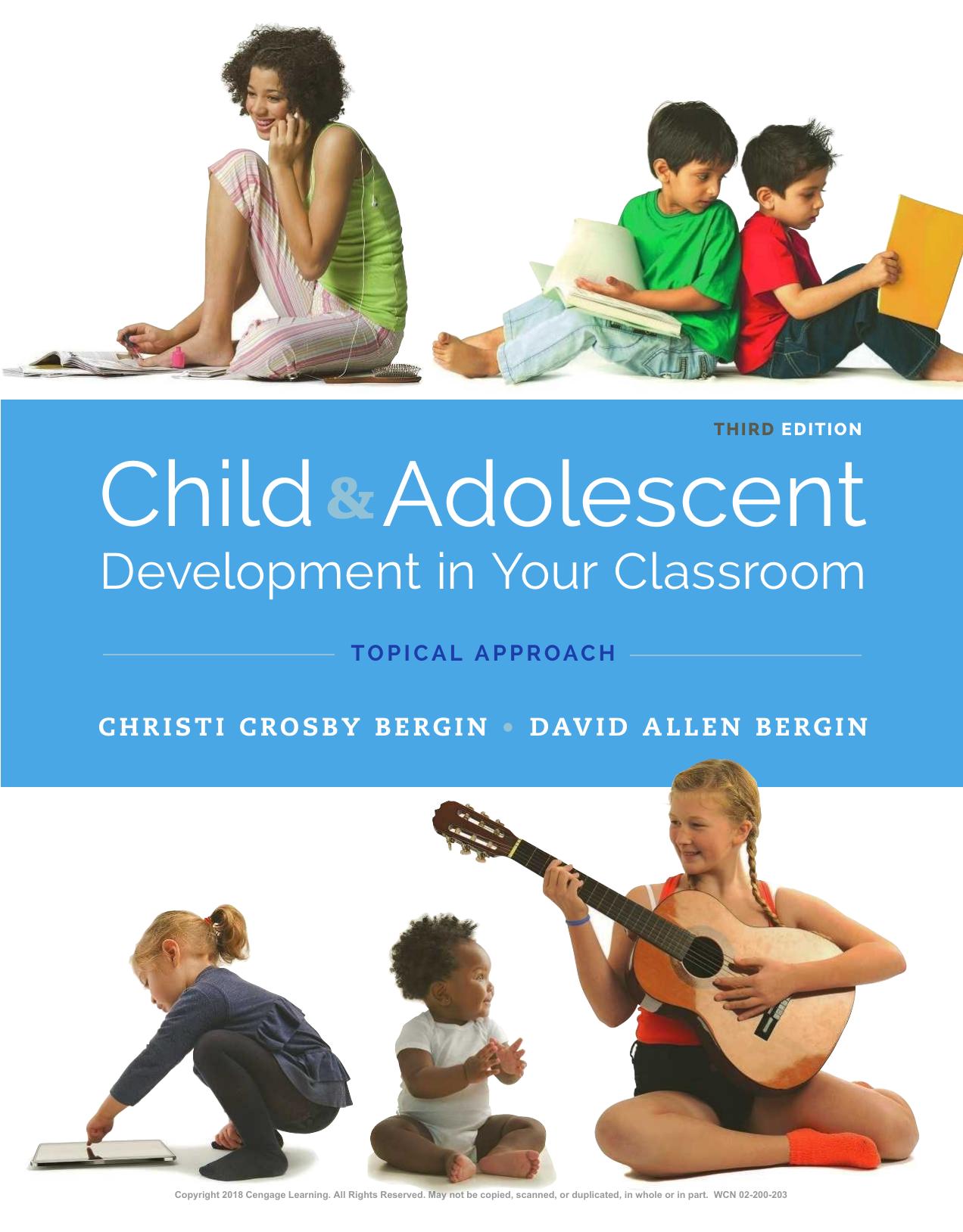Child and Adolescent Development in Your Classroom 3rd edition by Christi Crosby Bergin, David Allen Bergin ISBN 8214339610 9798214339610
$70.00 Original price was: $70.00.$35.00Current price is: $35.00.
Instant download Child and Adolescent Development in Your Classroom 3rd Christi Crosby Bergin & David Allen Bergin after payment
Child and Adolescent Development in Your Classroom 3rd edition by Christi Crosby Bergin, David Allen Bergin – Ebook PDF Instant Download/Delivery: 8214339610, 9798214339610
Full download Child and Adolescent Development in Your Classroom 3rd edition after payment

Product details:
ISBN 10: 8214339610
ISBN 13: 9798214339610
Author: Christi Crosby Bergin, David Allen Bergin
Covering development from early childhood through high school in an easy-to-follow format, this book provides you with authentic, research-based strategies and guidelines for your future classrooms. The authors apply child development concepts to topics of high interest and relevance to teachers, including social-emotional development, classroom discipline, humor, constructivism, and many others. Group and individual diversity and multicultural issues are integrated throughout. Case studies and real-world vignettes further bridge the distance between research and the classroom, helping to prepare you to create an environment that promotes optimal development in children. With its practical classroom-based focus, this text will help you view all students more positively, give you the tools to deal effectively with them, and make teaching more enjoyable.
Child and Adolescent Development in Your Classroom 3rd Table of contents:
Section 1. Foundations of Child Development
Chapter 1. Ways of Thinking about Children
1-1. The Science of Child Development
1-1a. Child Development Theories: A Brief Overview
1-1b. Research Methods
1-2. Nature and Nurture
1-2a. Nature: The Role of Genes in Individual Diversity
1-2b. Nurture: The Role of Culture in Group Diversity
1-2c. Reconciling the Role of Genes and Culture
1-3. Risk and Resilience
1-3a. Protective Factors
1-3b. Accumulation of Risk
1-3c. Stability in Development
1-3d. Maternal Depression as a Risk Factor
1-3e. Poverty as a Risk Factor
1-4. Classroom Implications: The Case of School Readiness and Preschool
1-4a. School Readiness
1-4b. What Does the Research on Preschools for Children at Risk Say?
Reflections on Practice: My Teaching
Chapter Summary
Chapter 2. Physical Development and Health
2-1. The Brain
2-1a. Structure and Function of the Brain
2-1b. Age Trends in Brain Development
2-1c. Individual Diversity in Brain Development
2-1d. Classroom Implications of Brain Development
2-2. Growth and Motor Development
2-2a. Age Trends in Growth and Motor Development
2-2b. Individual Diversity in Growth and Motor Development
2-2c. Group Diversity in Growth and Motor Development
2-2d. Classroom Implications of Growth and Motor Development
2-3. Contemporary Health Challenges
2-3a. Sleep Deprivation
2-3b. Obesity and Other Eating Disorders
2-3c. Drug Use
Reflections on Practice: My Teaching
Summary of Age Trends in Physical Development
Chapter Summary
Section 2. The Cognitive Child
Chapter 3. Classic Theories of Learning and Cognition
3-1. Behaviorism
3-1a. Classical Conditioning
3-1b. Operant Conditioning
3-1c. Classroom Implications of Behaviorism
3-2. Piaget’s Theory of Cognitive Development
3-2a. Age Trends in Piaget’s Cognitive Developmental Theory
3-2b. Advances in Knowledge since Piaget
3-2c. Diversity in Cognitive Developmental Theory
3-2d. Classroom Implications of Cognitive Developmental Theory
3-3. Vygotsky’s Sociocultural Theory
3-3a. The Role of Social Interaction
3-3b. Zone of Proximal Development
3-3c. Scaffolding
3-3d. Language and Private Speech
3-3e. Age Trends in Sociocultural Theory
3-3f. Diversity in Sociocultural Theory
3-3g. Classroom Implications of Sociocultural Theory
3-4. Comparing Theories of Learning and Cognition
Reflections on Practice: My Teaching
Summary of Age Trends in Learning and Cognition
Chapter Summary
Chapter 4. Information Processing, Memory, and Problem Solving
4-1. Information Processing
4-1a. Components of the Information-Processing Model
4-1b. Age Trends in Information Processing
4-1c. Individual Diversity in Information Processing
4-1d. Classroom Implications of Information Processing
4-2. Memory
4-2a. Remember? Maybe, Maybe Not
4-2b. Age Trends in Memory
4-2c. Individual Diversity in Memory
4-2d. Classroom Implications of Memory
4-3. Reasoning and Problem Solving
4-3a. Age Trends in Reasoning and Problem Solving
4-3b. Individual Diversity in Reasoning and Problem Solving
4-3c. Classroom Implications of Reasoning and Problem Solving
4-4. Putting the Theories to Work: The Case of Mathematics
4-4a. Age Trends in Mathematics
4-4b. Implications for Teachers from Different Theories
Reflections on Practice: My Teaching
Summary of Age Trends in Information Processing
Chapter Summary
Chapter 5. Cognitive Ability: Intelligence, Talent, and Achievement
5-1. Intelligence
5-1a. What Is Intelligence?
5-1b. Individual Diversity in Intelligence
5-1c. Group Diversity in Intelligence
5-1d. Classroom Implications of Intelligence
5-2. Talent and Expertise
5-2a. Age Trends in Talent and Expertise
5-2b. Individual Diversity in Talent and Expertise
5-2c. Group Diversity in Talent and Expertise
5-2d. Classroom Implications of Talent and Expertise
5-3. Achievement
5-3a. Age Trends in Achievement
5-3b. Individual Diversity in Achievement
5-3c. Group Diversity in Achievement
5-3d. Classroom Implications of Research on Achievement
Reflections on Practice: My Teaching
Summary of Age Trends in Cognitive Ability
Chapter Summary
Section 3. The Emotional Child
Chapter 6. Attachment and Personality
6-1. Attachment
6-1a. Age Trends in Attachment
6-1b. Individual Diversity in Attachment
6-1c. Group Diversity in Attachment
6-1d. Classroom Implications of Attachment
6-2. Temperament and Personality
6-2a. Age Trends in Temperament and Personality
6-2b. Individual Diversity in Temperament and Personality
6-2c. Group Diversity in Temperament and Personality
6-2d. Classroom Implications of Temperament and Personality
Reflections on Practice: My Teaching
Summary of Age Trends in Learning and Cognition
Chapter Summary
Chapter 7. Self-Control and Discipline
7-1. Self-Control
7-1a. Age Trends in Self-Control
7-1b. Individual Diversity in Self-Control
7-1c. Group Diversity in Self-Control
7-1d. Classroom Implications of Self-Control
7-2. Effective Discipline
7-2a. The Goal of Discipline
7-2b. Types of Discipline
7-2c. Principles of Effective Discipline
7-2d. Group Diversity in Discipline
7-2e. Classroom Implications of Discipline
7-3. Teaching Self-Control: What Parenting Styles Tell Us
7-3a. Four Styles of Parenting
7-3b. Group Diversity in Parenting Style
7-3c. Classroom Implications of Parenting Style
Reflections on Practice: My Teaching
Summary of Age Trends in Self-Control and Discipline
Chapter Summary
Chapter 8. Emotional Development
8-1. Emotions
8-1a. What Emotions Do Children Have?
8-1b. Why Do Children Have Emotions?
8-1c. Emotions Influence Learning and Thought
8-2. Regulating One’s Own Emotions
8-2a. Strategies to Regulate Emotion
8-2b. Emotional Dissemblance—Faking It
8-2c. Age Trends in Emotion Regulation
8-2d. Individual Diversity in Emotion Regulation
8-2e. Depression and Anxiety: Emotion Regulation gone Awry
8-2f. Group Diversity in Emotion Regulation
8-2g. Classroom Implications of Emotion Regulation
8-3. Understanding others’ Emotions
8-3a. Age Trends in Understanding Others’ Emotions
8-3b. Individual Diversity in Understanding Others’ Emotions
8-3c. Group Diversity in Understanding Others’ Emotions
8-3d. Classroom Implications of Understanding Others’ Emotions
Reflections on Practice: My Teaching
Summary of Age Trends in Emotional Competence
Chapter Summary
Section 4. The Social Child
Chapter 9. Social Cognition
9-1. Theory of Mind
9-1a. Age Trends in Theory of Mind
9-1b. Individual Diversity in Theory of Mind
9-1c. Group Diversity in Theory of Mind
9-1d. Classroom Implications of Theory of Mind
9-2. Humor
9-2a. What is Humor?
9-2b. Age Trends in Humor
9-2c. Individual Diversity in Humor
9-2d. Group Diversity in Humor
9-2e. Classroom Implications of Humor
9-3. Moral Judgment
9-3a. Different Views of Moral Judgment
9-3b. Age Trends in Moral Judgment
9-3c. Individual Diversity in Moral Judgment
9-3d. Group Diversity in Moral Judgment
9-3e. Classroom Implications of Moral Judgment
Reflections on Practice: My Teaching
Summary of Age Trends in Social Cognition
Chapter Summary
Chapter 10. Social Behavior
10-1. Prosocial Behavior
10-1a. Age Trends in Prosocial Behavior
10-1b. Individual Diversity in Prosocial Behavior
10-1c. Gender Diversity in Prosocial Behavior
10-1d. Classroom Implications of Prosocial Behavior
10-2. Antisocial Behavior and Aggression
10-2a. Types of Aggression
10-2b. Age Trends in Antisocial Behavior
10-2c. Individual Diversity in Antisocial Behavior
10-2d. Group Diversity in Antisocial Behavior
10-2e. Classroom Implications of Antisocial Behavior
10-3. Conflict Resolution
10-3a. How Should Conflict Be Resolved?
10-3b. Age Trends in Conflict Resolution
10-3c. Individual Diversity in Conflict Resolution
10-3d. Classroom Implications of Conflict Resolution
Reflections on Practice: My Teaching
Summary of Age Trends in Social Behavior
Chapter Summary
Chapter 11. Peers, Friends, and Play
11-1. Peer Status
11-1a. Individual Diversity in Peer Status
11-1b. Group Diversity in Peer Status
11-1c. Classroom Implications of Peer Status
11-2. Friendship and Peer Networks
11-2a. Birds of a Feather Flock Together
11-2b. Peer Pressure: Is It Good or Bad?
11-2c. Age Trends in Friendship and Peer Networks
11-2d. Individual Diversity in Friendship and Peer Networks
11-2e. Group Diversity in Friendship and Peer Networks
11-2f. Classroom Implications of Friendship and Peer Networks
11-3. Play
11-3a. Types of Play
11-3b. Age Trends in Play
11-3c. Individual Diversity in Play
11-3d. Group Diversity in Play
11-3e. Classroom Implications of Play
Reflections on Practice: My Teaching
Summary of Age Trends in Peer Status, Friendship, and Play
Chapter Summary
Section 5. The Whole Child
Chapter 12. Language and Literacy
12-1. Language Development
12-1a. Types of Language: Nonverbal and Verbal
12-1b. Age Trends in Language
12-1c. Individual Diversity in Language
12-1d. Group Diversity in Language
12-1e. Classroom Implications of Language
12-2. Literacy
12-2a. Age Trends in Literacy
12-2b. Individual Diversity in Literacy
12-2c. Group Diversity in Literacy
12-2d. Classroom Implications of Literacy Development
12-3. Putting the Theories to Work: The Case of Literacy
12-3a. Implications for Teachers from Different Theories
12-3b. Comparing the Theories
Reflections on Practice: My Teaching
Summary of Age Trends in Language and Literacy
Chapter Summary
Chapter 13. The Self-System and Motivation
13-1. The Self-System
13-1a. Self-Esteem, Self-Concept, and Self-Efficacy
13-1b. Age Trends in the Self
13-1c. Individual Differences in the Self
13-1d. Group Diversity in the Self
13-1e. Classroom Implications of the Self
13-2. Social Identity: Gender and Ethnicity
13-2a. Gender Identity
13-2b. Ethnic Identity
13-2c. Sexism and Racism
13-2d. Classroom Implications of Gender and Ethnic Identity
13-3. Motivation
13-3a. Can I Do This?
13-3b. Classroom Implications of “Can I Do This?”
13-3c. Do I Want to Do This?
13-3d. Classroom Implications of “Do I Want to Do This?”
Reflections on Practice: My Teaching
Summary of Age Trends in the Self-System and Motivation
Chapter Summary
Chapter 14. The Child in Context: Family Structure, Child Care, and Media
14-1. Family Structure
14-1a. What Does Family Structure Predict?
14-1b. How Might Family Structure Influence Children?
14-1c. Group Diversity in Family Structure
14-1d. Classroom Implications of Family Structure and Parent Involvement
14-2. Maternal Employment and Child Care
14-2a. Maternal Employment
14-2b. Child Care
14-2c. Age Trends in Child Care
14-2d. What Does Child Care Predict?
14-2e. Group Diversity in Child Care
14-2f. Classroom Implications of Maternal Employment and Child Care
14-3. Television and Other Media
14-3a. The Issue of Time
14-3b. The Issue of Content
14-3c. Age Trends in Media Use
14-3d. Individual Diversity in Media Use
14-3e. Group Diversity in Media Use
14-3f. Classroom Implications of Media Use
14-4. Farewell
Reflections on Practice: My Teaching
Summary of Age Trends of the Child in Context
Chapter Summary
Teaching Standards Alignment
Teaching Standards Alignment
References
People also search for Child and Adolescent Development in Your Classroom 3rd:
child and adolescent development in your classroom pdf
child and adolescent development in your classroom chronological approach pdf
child and adolescent development in your classroom chronological approach
child and adolescent development in your classroom 3rd edition
child and adolescent development in your classroom bergin
Tags: Christi Crosby Bergin, David Allen Bergin, Adolescent Development, Your Classroom


